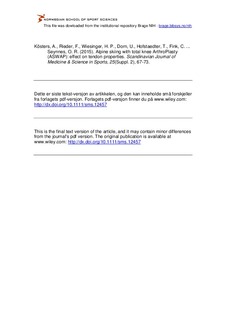| dc.contributor.author | Kösters, Alexander | |
| dc.contributor.author | Rieder, Florian | |
| dc.contributor.author | Wiesinger, Hans-Peter | |
| dc.contributor.author | Dorn, U. | |
| dc.contributor.author | Hofstaedter, T. | |
| dc.contributor.author | Fink, Christian | |
| dc.contributor.author | Müller, Erich | |
| dc.contributor.author | Seynnes, Olivier R. | |
| dc.date.accessioned | 2016-08-25T08:36:28Z | |
| dc.date.available | 2016-08-25T08:36:28Z | |
| dc.date.issued | 2015-06-10 | |
| dc.identifier.citation | Scandinavian Journal of Medicine & Science in Sports. 2015, 25, 67–73 | nb_NO |
| dc.identifier.uri | http://hdl.handle.net/11250/2401578 | |
| dc.description | I Brage finner du siste tekst-versjon av artikkelen, og den kan inneholde ubetydelige forskjeller fra forlagets pdf-versjon. Forlagets pdf-versjon finner du på onlinelibrary.wiley.com / In Brage you'll find the final text version of the article, and it may contain insignificant differences from the journal's pdf version. The definitive version is available at onlinelibrary.wiley.com | nb_NO |
| dc.description.abstract | The aim of this study was to investigate the effect of alpine skiing on patellar tendon properties in patients with total knee arthroplasty (TKA). Thirty-one adults (70.4 ± 4.7 years) with unilateral TKA were recruited 2.7 ± 0.9 years after surgery and assigned to an intervention (IG) or a control group (CG). The IG underwent a 12-week guided skiing program. Tendon stiffness, Young's modulus, and cross-sectional area (CSA) were measured before and after the intervention. In both groups, mean tendon CSA was 28% (P < 0.001) larger in the operated (OP) than in the non-operated (NOP) leg at baseline, without any difference in other tendon properties. After training, stiffness increased in the IG by 5.8% and 15.8%, respectively, in the OP and NOP legs. Likewise, mean CSA increased in the IG by 2.9% in the OP and 3.8% in the NOP leg, whereas no significant changes were found for the Young's modulus. None of the tendon parameters changed in the CG. Results indicate that patellar tendon structure and/or loading pattern are altered following TKA, but this tissue seems to retain its adaptation capacity. Further, alpine skiing appears to offer a suitable rehabilitation strategy for TKA patients. | nb_NO |
| dc.language.iso | eng | nb_NO |
| dc.publisher | John Wiley & Sons Ltd | nb_NO |
| dc.subject | mechanical properties | nb_NO |
| dc.subject | material properties | nb_NO |
| dc.subject | ultrasonography | nb_NO |
| dc.subject | tendon cross-sectional area | nb_NO |
| dc.title | Alpine skiing with total knee arthroplasty (ASWAP): effect on tendon properties | nb_NO |
| dc.type | Journal article | nb_NO |
| dc.type | Peer reviewed | nb_NO |
| dc.subject.nsi | VDP::Social science: 200 | nb_NO |
| dc.subject.nsi | VDP::Social science: 200::Social science in sports: 330 | nb_NO |
| dc.subject.nsi | VDP::Social science: 200::Social science in sports: 330::Other subjects within physical education: 339 | nb_NO |
| dc.source.journal | Scandinavian Journal of Medicine & Science in Sports | nb_NO |
| dc.identifier.doi | 10.1111/sms.12457 | |
| dc.description.localcode | Seksjon for fysisk prestasjonsevne / Department of Physical Performance | nb_NO |
